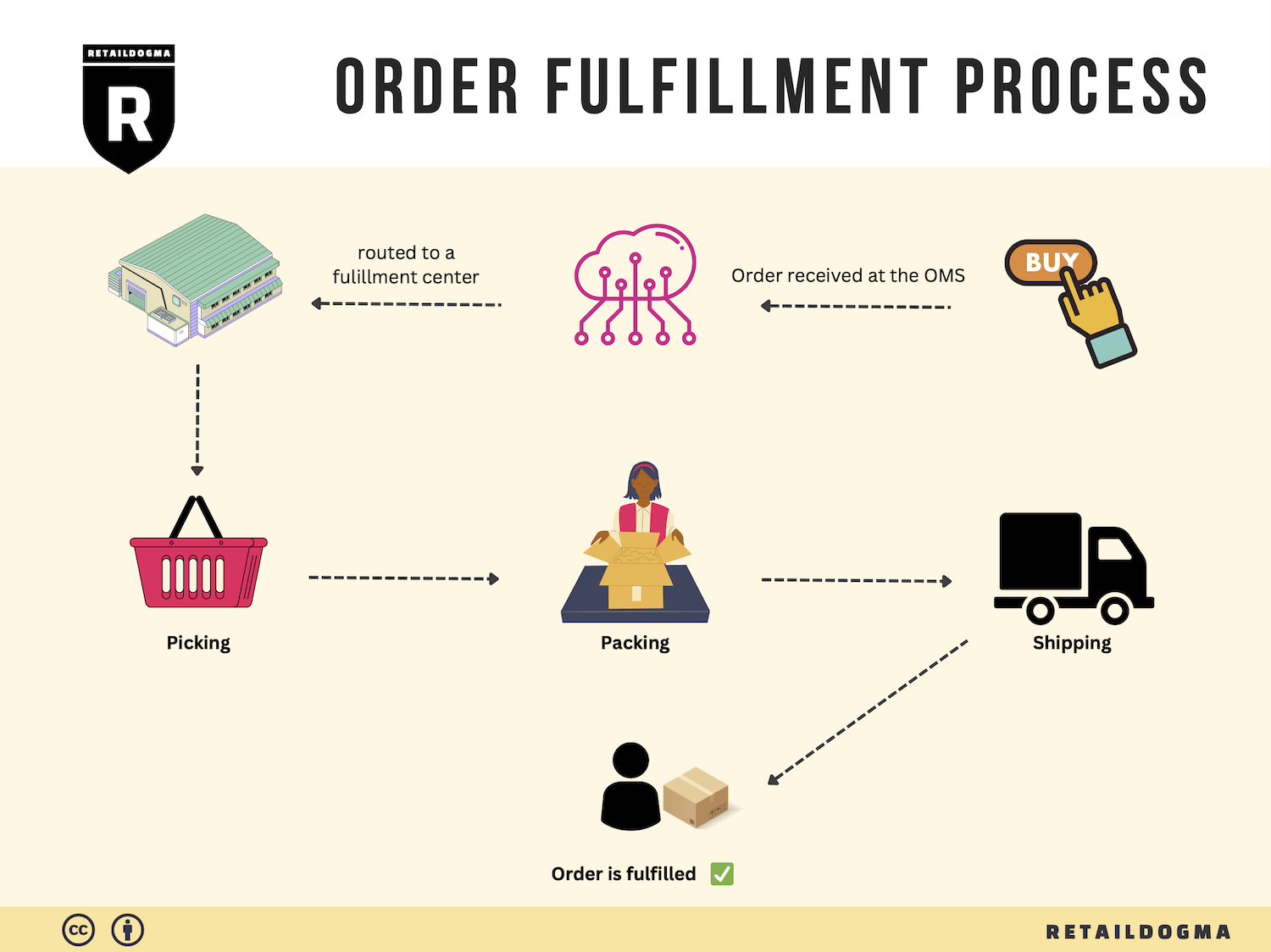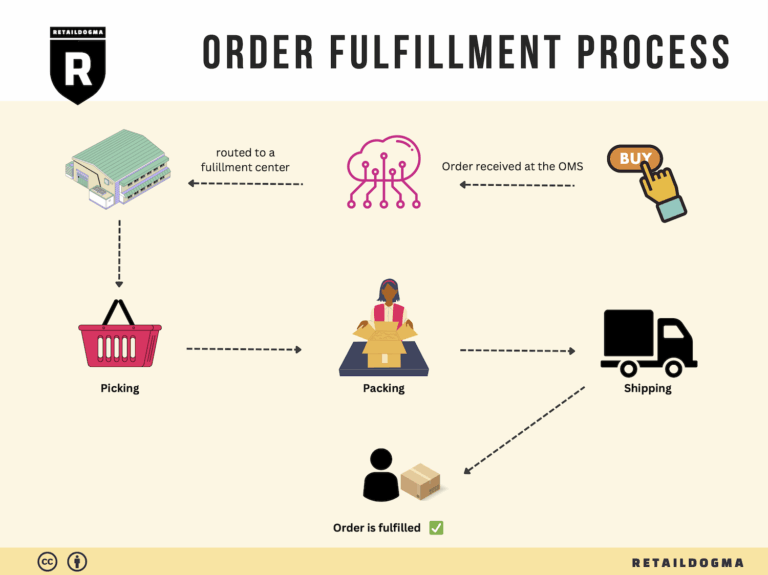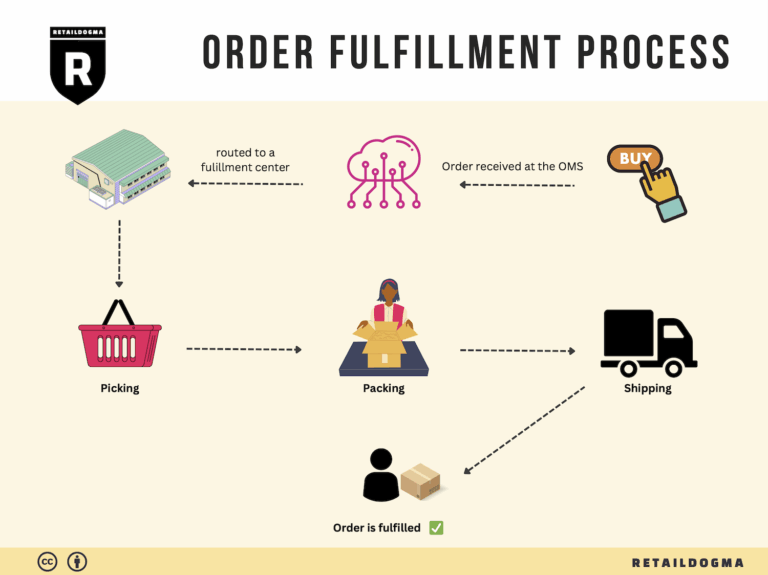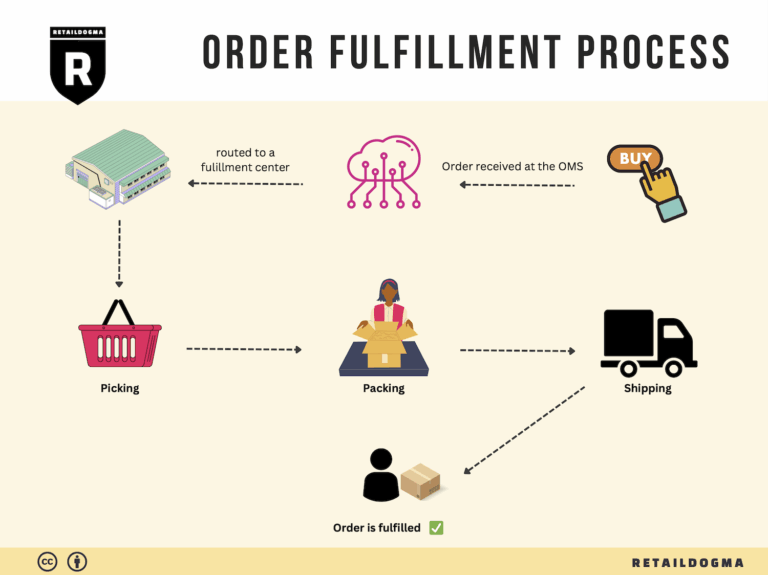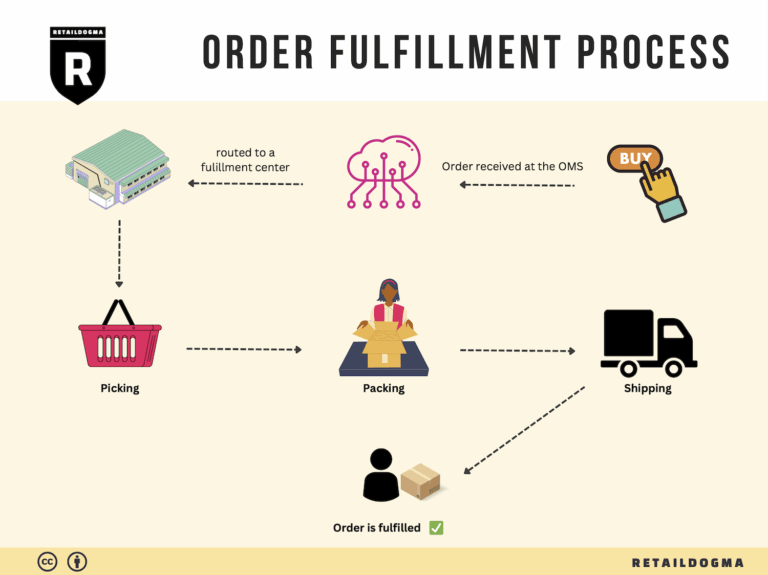What Is A Fulfillment Center? A Complete Guide (2025)
What is E-commerce Fulfillment? An Introduction for Growing Businesses
As an e-commerce business owner, you may find yourself grappling with the increasing complexities of packing and shipping orders. The excitement of growing sales can quickly turn into frustration when faced with the logistical challenges of fulfilling orders efficiently. This is where understanding e-commerce fulfillment becomes crucial. In its simplest form, fulfillment is the process of getting a product from your inventory to your customer’s doorstep. It encompasses everything from receiving orders to picking, packing, and shipping products.
Understanding Fulfillment Models
In this guide, we will explore various fulfillment models that can suit your business needs. You’ll learn about traditional third-party logistics (3PL) providers, which offer comprehensive warehousing and shipping services, as well as Fulfillment by Amazon (FBA), a popular option for sellers looking to leverage Amazon’s extensive distribution network. Each model has its own set of advantages and considerations that can impact your operational efficiency and customer satisfaction.
Core Fulfillment Services
We will delve into the core services involved in the fulfillment process. This includes inventory management, order processing, and shipping logistics. Understanding these components will help you identify which services are essential for your business and how they can be optimized to enhance your operations.
Choosing the Right Fulfillment Partner
Selecting the right fulfillment partner can be a game-changer for your business. We will provide insights on what to look for in a fulfillment provider, including scalability, technology integration, and customer service. By understanding the key factors that differentiate providers, you can make an informed decision that aligns with your growth strategy.
Pricing Considerations
Finally, pricing is always a critical factor in choosing a fulfillment solution. We will break down common pricing models and offer tips on how to evaluate costs effectively. This knowledge will empower you to negotiate better terms and ensure that your fulfillment strategy remains cost-effective as you scale.
Empowering Your Logistics Decisions
Our goal with this guide is to empower you with the knowledge and tools necessary to make smart logistics decisions. As you navigate the complexities of e-commerce fulfillment, understanding your options will allow you to streamline operations, improve customer satisfaction, and ultimately drive growth. Whether you’re just starting out or looking to optimize your existing processes, this guide will serve as a valuable resource on your journey toward fulfillment excellence.
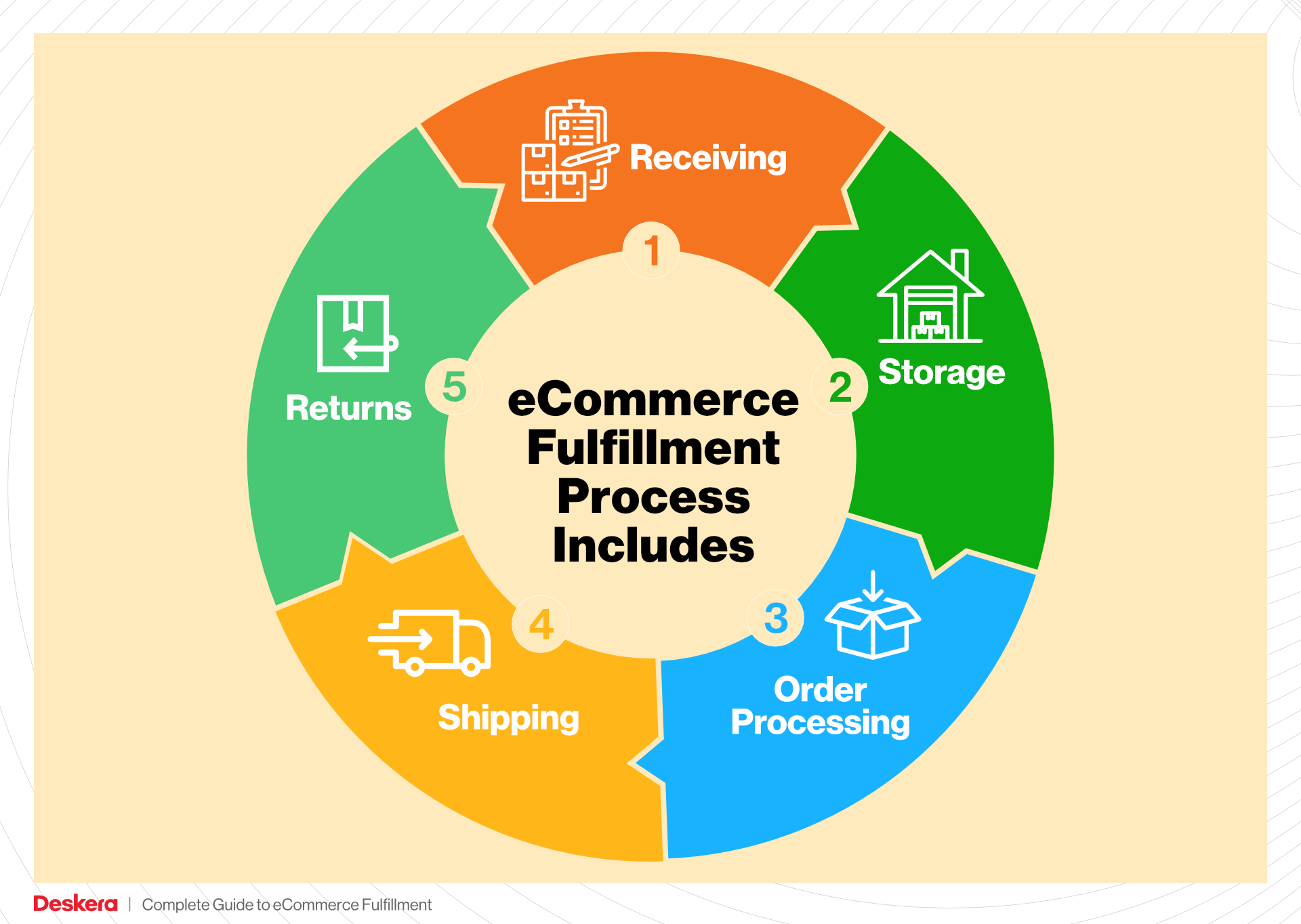
What You’ll Learn In This Guide
- What is E-commerce Fulfillment? An Introduction for Growing Businesses
- The Order Fulfillment Process: From ‘Buy’ Button to Customer’s Door
- Comparing Fulfillment Models: In-House vs. 3PL vs. Dropshipping
- A Deep Dive into Amazon FBA: Pros, Cons, and Who It’s For
- Core Services Offered by Fulfillment Centers
- How to Choose a Fulfillment Partner: A 6-Point Checklist
- Understanding Fulfillment Pricing: A Breakdown of Common Fees
- Frequently Asked Questions (FAQs) about Fulfillment
- Conclusion: Is Outsourcing Fulfillment the Right Move for Your Business?
- Important Disclaimer
The Order Fulfillment Process: From ‘Buy’ Button to Customer’s Door
1. Receiving Inventory
The order fulfillment process begins with receiving inventory at the fulfillment center. This is where products arrive from manufacturers or suppliers and are checked for accuracy and quality. Upon arrival, items are unloaded and scanned to ensure that the correct quantities and types of products have been received. This stage is crucial because it lays the foundation for the entire fulfillment operation.
Importance: Effective inventory receiving minimizes errors and discrepancies, ensuring that your stock levels are accurate. This accuracy is essential for maintaining customer trust and optimizing inventory management.
Key Term: SKU (Stock Keeping Unit) – This unique identifier helps in tracking inventory accurately and efficiently throughout the fulfillment process.
2. Warehouse Storage
Once the inventory is received, the next step is warehouse storage. Products are organized and stored in designated areas within the fulfillment center. This can involve placing items on shelves, in bins, or in other storage systems. Amazon employs advanced technology, including barcode scanning and inventory management systems, to facilitate this process.
Importance: Proper organization and storage of inventory enhance retrieval efficiency, allowing for quicker order fulfillment. A well-structured warehouse minimizes the time spent searching for products, thus speeding up the entire process.

Key Term: FIFO (First In, First Out) – This inventory management method ensures that older stock is sold before newer stock, reducing the risk of obsolescence and waste.
3. Order Picking
When a customer places an order, the next step is order picking. This involves selecting the correct items from their storage locations to fulfill the order. Fulfillment centers often utilize pick lists, which detail the items needed for each order. In advanced operations like Amazon’s, robotic systems may assist human pickers by bringing items closer to them, streamlining the picking process.
Importance: Accurate order picking is vital for customer satisfaction. Errors at this stage can lead to incorrect shipments, resulting in returns and unhappy customers. Efficient picking processes also reduce operational costs by optimizing labor and time.
Key Term: Pick List – A document or digital format that specifies the items and quantities needed to fulfill a particular order, guiding pickers through the warehouse.
4. Order Packing
After the items have been picked, they move to the order packing stage. Here, items are carefully packed into boxes or envelopes, often using automated systems that recommend the most appropriate packaging based on the size and shape of the items. This stage also includes scanning the items again to ensure accuracy and quality control.
Importance: Effective packing protects products during transit and ensures they arrive in good condition. Additionally, optimizing box sizes and minimizing packaging materials can reduce shipping costs and environmental impact.
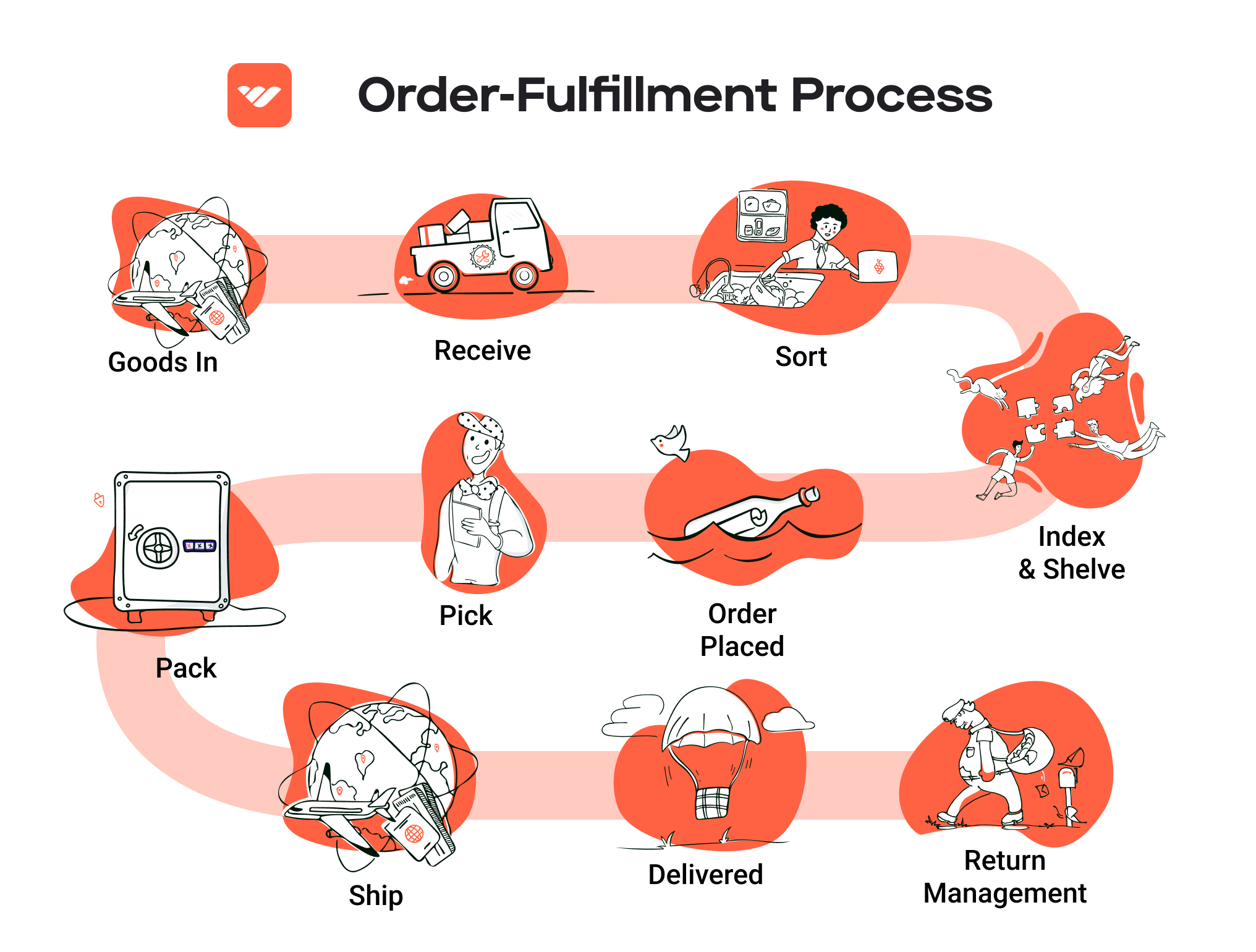
Key Term: Packing Slip – A document included with the shipment that lists the items in the order, providing confirmation to the customer and serving as a reference for returns.
5. Shipping & Delivery
The final step in the order fulfillment process is shipping and delivery. Once packed, orders are labeled and sorted based on their destination and shipping method. Fulfillment centers use advanced technologies, such as SLAM (Scan, Label, Apply, Manifest) systems, to expedite this process. Packages are then dispatched using various transportation methods, including Amazon’s own delivery network and third-party carriers.
Importance: Timely shipping is critical for customer satisfaction, especially for businesses that promise fast delivery. Efficient logistics management ensures that orders reach customers promptly, enhancing their overall experience and encouraging repeat business.
Key Term: Last Mile Delivery – The final step of the delivery process where the package is transported from a distribution hub to the customer’s doorstep. This is often the most complex and costly part of the shipping process, making it a key area for optimization.
By understanding and optimizing each of these steps in the order fulfillment process, e-commerce businesses can enhance efficiency, reduce costs, and ultimately improve customer satisfaction. Each component plays a critical role in ensuring that products move seamlessly from the ‘buy’ button to the customer’s door.
Comparing Fulfillment Models: In-House vs. 3PL vs. Dropshipping
Fulfillment Models Comparison
| Model | Who Handles Inventory | Best For (Business Stage) | Key Advantage | Key Disadvantage |
|---|---|---|---|---|
| In-House Fulfillment | Business itself | Established businesses with stable order volume | Full control over inventory and processes | High overhead costs and resource commitment |
| Third-Party Logistics (3PL) | External logistics provider | Growing businesses looking to scale | Access to expertise and scalable resources | Less control over inventory and processes |
| Dropshipping | Supplier or manufacturer | Startups and small businesses with limited capital | Low upfront costs and minimal risk | Lower profit margins and reliance on supplier |
In-House Fulfillment
In-house fulfillment refers to the process where a business manages its own inventory and order fulfillment operations. This model is most suitable for established businesses with a stable volume of orders, as it requires significant resources and infrastructure. By maintaining control over inventory, businesses can customize their fulfillment processes to meet specific customer needs, ensuring a high level of service. Additionally, in-house fulfillment allows for better quality control, as the business can directly manage how products are stored, picked, packed, and shipped. However, this model comes with considerable overhead costs, including warehousing, staffing, and technology investments. As order volumes fluctuate, businesses may find it challenging to maintain efficiency and manage operational costs effectively.
Third-Party Logistics (3PL)
Third-party logistics (3PL) providers offer outsourced logistics services that encompass the entire supply chain process, from storage and inventory management to order fulfillment and shipping. This model is ideal for growing businesses that need to scale operations without the burden of managing logistics themselves. Partnering with a 3PL allows businesses to leverage their expertise, advanced technology, and established networks, which can significantly enhance fulfillment speed and accuracy. Moreover, 3PLs often provide flexible storage solutions, allowing businesses to adjust their inventory levels based on demand. However, the downside is that businesses may have less control over inventory management and fulfillment processes, which could lead to inconsistencies in service quality. Additionally, reliance on a third party can create potential risks related to communication and coordination.
Dropshipping
Dropshipping is a fulfillment model where the retailer does not hold inventory but instead relies on suppliers or manufacturers to ship products directly to customers. This model is particularly appealing for startups and small businesses with limited capital, as it requires minimal upfront investment in inventory. With dropshipping, businesses can offer a wide range of products without the financial risk associated with unsold inventory. Furthermore, it allows entrepreneurs to focus on marketing and customer service rather than logistics. However, dropshipping comes with its own set of challenges, including lower profit margins due to reliance on suppliers for fulfillment. Additionally, businesses may face issues related to product quality, shipping times, and customer service, as they have little control over the fulfillment process. This model can also lead to increased competition, as many businesses may sell the same products from the same suppliers.
Conclusion
Choosing the right fulfillment model is crucial for e-commerce businesses aiming to scale effectively. Each model—In-house, 3PL, and Dropshipping—has its own advantages and disadvantages that must be carefully considered in light of the business’s current stage, resources, and long-term goals. For established companies with stable order volumes, in-house fulfillment may provide the control and customization needed to deliver exceptional service. Conversely, growing businesses may benefit from the expertise and scalability of 3PL providers, while startups can take advantage of the low-risk, low-cost nature of dropshipping. Ultimately, the decision will depend on the specific operational needs, customer expectations, and financial capacities of the business.
A Deep Dive into Amazon FBA: Pros, Cons, and Who It’s For
Understanding Fulfillment by Amazon (FBA)
Fulfillment by Amazon (FBA) is a service offered by Amazon that allows sellers to store their products in Amazon’s fulfillment centers. When customers order these products, Amazon takes care of the storage, packaging, shipping, and customer service. This service is particularly appealing to e-commerce business owners looking to scale their operations without the burden of managing logistics themselves.
How FBA Works
-
Inventory Preparation and Shipping: Sellers prepare their products according to Amazon’s guidelines, which include packaging and labeling requirements. Once ready, they ship their products directly to an Amazon fulfillment center.
-
Storage: Upon arrival, products are stored in Amazon’s warehouses. The fulfillment centers are strategically located across the United States and around the world, enabling efficient distribution.
-
Order Processing: When a customer places an order for an FBA product, Amazon automatically processes the order. This includes picking the item from the warehouse, packing it, and shipping it directly to the customer.
-
Customer Service and Returns: Amazon also handles all customer service inquiries and returns for FBA products, allowing sellers to focus on growing their business rather than handling customer interactions.
Pros of Fulfillment by Amazon (FBA)
1. Prime Eligibility
One of the significant advantages of FBA is that products become eligible for Amazon Prime. This means that Prime members can receive their orders with free two-day shipping, which can lead to increased sales. Many customers prefer Prime-eligible products, making them more likely to choose FBA products over non-FBA alternatives.
2. Customer Trust
Selling through Amazon provides a level of trust that can be hard to achieve independently. Customers often feel more secure purchasing from a platform that offers robust customer service and returns processing. As a result, products fulfilled by Amazon can benefit from higher conversion rates and customer loyalty.
3. Multi-Channel Fulfillment
FBA also offers the option for multi-channel fulfillment, meaning sellers can use Amazon’s logistics to fulfill orders from other sales channels, such as their own website or other e-commerce platforms. This flexibility allows businesses to streamline their operations and maintain a consistent delivery experience across different sales platforms.
4. Time and Resource Efficiency
By leveraging Amazon’s fulfillment network, sellers can save significant time and resources. Instead of managing inventory, shipping, and customer service, they can focus on product development, marketing, and growth strategies. This efficiency can lead to a more scalable business model.
Cons of Fulfillment by Amazon (FBA)
1. High Fees
While FBA offers many benefits, it also comes with various fees that can add up quickly. Sellers are charged for storage space, fulfillment fees per unit sold, and additional costs for long-term storage if inventory remains unsold for an extended period. These fees can significantly impact profit margins, especially for low-cost items.
2. Strict Inventory Rules
Amazon has stringent policies regarding inventory management. Sellers must adhere to specific guidelines for labeling, packaging, and shipping their products. Failure to comply can result in additional fees or even suspension of selling privileges. This can be particularly challenging for small businesses that may lack the resources to manage these requirements effectively.
3. Commingling Risks
FBA operates on a commingling model, meaning that products from different sellers can be stored together in the same fulfillment center. While this can streamline operations, it also poses risks. If a customer receives a defective item or an item from another seller, it could reflect poorly on your business. Managing brand reputation can be more challenging in this environment.
4. Limited Control Over Shipping
When using FBA, sellers relinquish control over the shipping process. While Amazon’s logistics are efficient, any issues with shipping or fulfillment are out of the seller’s hands. This can be frustrating for businesses that want to ensure a specific level of service or branding during the delivery process.
Who is FBA Best For?
Fulfillment by Amazon is best suited for e-commerce businesses that are looking to scale quickly without the complexities of managing logistics. Here are some specific scenarios where FBA can be especially beneficial:
-
Small to Medium-Sized Businesses: Companies that may not have the infrastructure to manage their own warehousing and shipping can benefit from FBA’s established logistics network.
-
Sellers with High Sales Volume: Businesses that anticipate significant sales volume can leverage FBA to handle order fulfillment efficiently, allowing them to focus on marketing and product development.
-
New Entrepreneurs: For new sellers entering the e-commerce space, FBA can provide a straightforward way to start selling without the immediate need for inventory management systems.
-
Brands Looking to Increase Visibility: Sellers looking to enhance their product visibility through Amazon Prime and the trust associated with the Amazon brand may find FBA to be an effective strategy.
In conclusion, Fulfillment by Amazon offers a powerful solution for e-commerce sellers aiming to streamline their operations and increase sales. By weighing the pros and cons, business owners can determine whether FBA aligns with their growth objectives and operational capabilities.
Core Services Offered by Fulfillment Centers
Inventory Management & Warehousing
Fulfillment centers provide robust inventory management and warehousing services that are crucial for e-commerce businesses. This service involves the systematic storage, tracking, and management of stock within a facility designed for optimal efficiency.
What It Is:
Inventory management includes receiving products from suppliers, storing them in designated areas, and maintaining accurate stock levels using advanced technology. Fulfillment centers utilize inventory management software to track items in real-time, enabling businesses to have visibility into their stock levels at any given moment.
Benefits to E-commerce Businesses:
Effective inventory management helps prevent stockouts and overstock situations, ensuring that businesses can meet customer demand without incurring unnecessary holding costs. By outsourcing warehousing to fulfillment centers, e-commerce businesses can scale their operations without the need for significant capital investment in physical space. Additionally, improved accuracy in inventory tracking reduces the risk of errors, leading to enhanced customer satisfaction through timely and accurate order fulfillment.
Pick and Pack Services
Pick and pack services are integral to the order fulfillment process, where orders are assembled based on customer requests. This service encompasses the picking of items from storage and packing them for shipment.
What It Is:
Once an order is placed, fulfillment centers generate picking lists that guide workers in retrieving the correct items from the warehouse. The ‘pick’ stage involves locating and collecting the ordered products, while the ‘pack’ stage includes securely packaging these items for shipment. Advanced fulfillment centers often employ automation and robotics to enhance the speed and accuracy of these processes.
Benefits to E-commerce Businesses:
Utilizing pick and pack services allows businesses to streamline their order fulfillment process significantly. By reducing the time taken to gather and package items, fulfillment centers help ensure that orders are shipped quickly, which is crucial for customer satisfaction, especially for businesses offering same-day or next-day delivery options. Moreover, a well-managed pick and pack operation minimizes errors, thereby reducing costs associated with returns and exchanges due to incorrect items being sent.
Kitting and Assembly
Kitting and assembly services involve bundling multiple products into a single package or preparing items for sale in a specific configuration. This service is particularly useful for e-commerce businesses that sell products that are often bought together or require assembly before they can be sold.
What It Is:
Kitting involves combining various products into a single kit, while assembly refers to putting together components to create a final product. For example, a fulfillment center might assemble a furniture piece by combining different parts and packaging them as a complete item ready for shipment.
Benefits to E-commerce Businesses:
Kitting and assembly services allow businesses to offer bundled products or complex items without needing to manage the assembly process in-house. This can lead to increased sales through the promotion of bundled offers and enhanced customer satisfaction by providing ready-to-use products. Furthermore, outsourcing these tasks to a fulfillment center frees up internal resources, allowing businesses to focus on core activities such as marketing and customer service.
Returns Management (Reverse Logistics)
Returns management, or reverse logistics, is a critical service offered by fulfillment centers that handles the process of managing returned products. This service is essential for maintaining customer satisfaction and operational efficiency.
What It Is:
Returns management involves receiving returned items, inspecting them for damage, restocking them if they are in sellable condition, and processing refunds or exchanges as necessary. Fulfillment centers often have specialized systems in place to handle returns efficiently, ensuring that the process is seamless for both the business and its customers.
Benefits to E-commerce Businesses:
A well-structured returns management process can significantly enhance customer loyalty and trust. By providing hassle-free returns, businesses can encourage repeat purchases, knowing that customers feel secure in their buying decisions. Additionally, effective returns management helps businesses minimize losses by quickly restocking sellable items and reducing the time products spend in the return process. This can lead to improved cash flow and inventory turnover, which are vital for scaling operations.
In conclusion, leveraging the core services offered by fulfillment centers—inventory management, pick and pack, kitting and assembly, and returns management—allows e-commerce businesses to streamline operations, enhance customer satisfaction, and scale effectively. By outsourcing these essential logistics functions, businesses can focus on strategic growth while ensuring a smooth and efficient fulfillment process.
How to Choose a Fulfillment Partner: A 6-Point Checklist
Location & Warehouse Network
When selecting a fulfillment partner, the location of their warehouses is crucial for ensuring timely delivery and minimizing shipping costs. A strategically located fulfillment center can significantly enhance your logistics efficiency, especially if you’re serving customers in specific regions.
Questions to Ask:
– Where are your warehouses located, and how does that align with my target customer base?
– Do you have a network of fulfillment centers that can help me reach my customers faster?
– How do you manage shipping times and costs based on your warehouse locations?
Technology & Integrations
In today’s digital age, robust technology and seamless integrations are essential for smooth order fulfillment. A fulfillment partner that uses advanced technology can provide real-time tracking, inventory management, and data analytics, which are vital for scaling your operations.
Questions to Ask:
– What technology platforms do you use for inventory management and order processing?
– Can your systems integrate with my existing e-commerce platform (e.g., Shopify, WooCommerce, Amazon)?
– Do you offer API access for custom integrations, and how do you handle updates or changes in technology?
Specializations (e.g., Cold Storage, Oversized Items)
Not all fulfillment centers are created equal. Depending on your product types, you may need a partner that specializes in certain areas, such as cold storage for perishables or handling oversized items that require special equipment and packaging.
Questions to Ask:
– What types of products do you specialize in fulfilling?
– Do you have facilities equipped for specific needs, such as temperature-controlled environments or heavy goods?
– How do you handle unique requirements for packaging and shipping specialized items?
Scalability & Capacity
As your business grows, your fulfillment partner must be able to scale operations accordingly. Understanding their capacity and scalability options ensures that you won’t face logistical bottlenecks as your order volume increases.
Questions to Ask:
– What is your current capacity, and how do you manage peak seasons or surges in order volume?
– Can you provide examples of how you’ve scaled operations for other clients?
– What are your policies for increasing storage space or order processing capabilities as my business grows?
Pricing and Contracts
Transparent pricing structures and flexible contracts are essential for maintaining profitability while managing fulfillment costs. Understanding the pricing model will help you avoid unexpected fees and ensure that your budget aligns with your fulfillment strategy.
Questions to Ask:
– What is included in your pricing model (e.g., storage fees, pick and pack fees, shipping costs)?
– Are there any additional fees I should be aware of, such as for returns or special handling?
– What are the terms of your contract, and is there flexibility for renegotiation based on my business growth?
Customer Support & Reviews
Exceptional customer support can make a significant difference in your fulfillment experience. A partner that is responsive and proactive in addressing issues can help you avoid potential disruptions. Additionally, researching reviews and testimonials from other clients can provide insight into their reliability and service quality.
Questions to Ask:
– What is your customer support structure? How can I reach you if issues arise?
– Can you provide references or testimonials from other clients, particularly those in my industry?
– How do you handle common fulfillment issues, such as shipping delays or inventory discrepancies?
Conclusion
Choosing the right fulfillment partner is a critical decision that can impact your e-commerce business’s efficiency and customer satisfaction. By considering the factors outlined in this checklist and asking the right questions, you can make an informed decision that aligns with your operational needs and growth objectives. Prioritize partners that not only meet your current requirements but also have the capacity and flexibility to support your future ambitions.
Understanding Fulfillment Pricing: A Breakdown of Common Fees
Initial Setup Fees
When partnering with a fulfillment center like Amazon’s CMH4, one of the first costs you may encounter is the initial setup fee. This fee is typically charged to establish your account and set up the necessary infrastructure to handle your inventory. It may cover tasks such as account creation, software integration, and initial training for your team on how to use the fulfillment system. The cost can vary widely based on the complexity of your operations and the specific services you require. Some fulfillment centers may waive this fee if you meet certain volume thresholds or commit to a long-term contract.
Receiving Fees
Receiving fees are charged when your inventory arrives at the fulfillment center. This cost is generally calculated based on the number of units received and the complexity of the receiving process. For instance, if your products require special handling, such as inspection or sorting, these fees may increase. Typically, fulfillment centers will charge a per-unit fee, which can range from a few cents to a couple of dollars per item, depending on the nature of the products and the efficiency of the receiving process.
Storage Fees (per pallet/bin)
Storage fees are incurred for the space your inventory occupies within the fulfillment center. These fees are usually calculated on a per-pallet or per-bin basis, with costs varying by the size and weight of the items stored. For example, a standard pallet may incur a monthly fee, while smaller items stored in bins could be charged on a weekly basis. It’s important to note that storage fees can accumulate quickly, particularly for slow-moving inventory, so understanding your turnover rate is critical for managing these costs effectively.
Pick & Pack Fees (per item/order)
Pick and pack fees are some of the most significant costs associated with fulfillment services. These fees cover the labor involved in retrieving items from storage (picking) and preparing them for shipment (packing). Charges are typically based on the number of items in an order or the total number of orders processed. For instance, fulfillment centers may charge a flat fee per item picked and packed, which can range from $1 to $5 depending on the service level and complexity of the packing process. Additionally, multi-item orders may incur additional fees, as they require more labor and resources to fulfill.
Shipping Fees
Shipping fees are incurred when your orders are dispatched to customers. These fees can vary widely based on several factors, including the shipping method chosen (e.g., standard, expedited, or international), the weight and dimensions of the package, and the destination. Fulfillment centers often provide discounted shipping rates through their partnerships with carriers, which can help reduce overall costs. It’s crucial to understand the pricing structure for shipping, as some fulfillment centers may charge a flat fee per shipment or base their costs on dimensional weight calculations.
Tips for Getting an Accurate Quote
-
Understand Your Needs: Before reaching out for quotes, have a clear understanding of your inventory levels, order volume, and specific requirements. This information will help fulfillment centers provide you with more accurate pricing.
-
Request Detailed Breakdown: When you receive quotes, ask for a detailed breakdown of all potential fees, including any variable costs associated with your specific products.
-
Compare Multiple Providers: Don’t settle for the first quote you receive. Compare offers from multiple fulfillment centers to ensure you’re getting a competitive rate.
-
Inquire About Volume Discounts: If you anticipate scaling your business, ask about volume discounts or tiered pricing structures that may apply as your order volume increases.
-
Consider Hidden Costs: Be mindful of potential hidden costs, such as fees for returns, inventory management, or additional services. Request clarification on any fees that seem unclear.
By understanding the various fulfillment pricing models and how they are calculated, you can make informed decisions that will help you scale your business effectively while managing costs.
Frequently Asked Questions (FAQs) about Fulfillment
1. What is the Amazon Fulfillment Center CMH4?
Amazon Fulfillment Center CMH4, located at 2301 Welsh Hills Rd, Granville, OH, is a large-scale facility that specializes in the storage, packing, and shipping of a wide range of products sold on Amazon. This center plays a crucial role in ensuring timely delivery of orders to customers, leveraging advanced technology and efficient logistics processes.
2. How does Amazon’s fulfillment process work?
The fulfillment process at Amazon involves several key steps: inventory receiving, storage, order processing, picking, packing, and shipping. Once an order is placed, the fulfillment center retrieves the item from storage, packs it according to specific guidelines, and ships it out using various transportation methods based on the delivery speed required.
3. What’s the difference between a warehouse and a fulfillment center?
A warehouse primarily focuses on the storage of goods, while a fulfillment center is designed to handle the entire order fulfillment process. Fulfillment centers not only store inventory but also manage picking, packing, and shipping orders directly to customers, making them essential for e-commerce operations.
4. What is a 3PL (Third-Party Logistics)?
A 3PL is a service provider that manages logistics and supply chain functions on behalf of businesses. This can include warehousing, fulfillment, and transportation services. Companies often partner with 3PLs to enhance efficiency and scalability without the need to invest in their own logistics infrastructure.
5. How much do fulfillment services cost?
The cost of fulfillment services can vary widely depending on several factors, including the volume of orders, the size and weight of products, and the specific services required (such as storage, packing, and shipping). It’s essential for businesses to evaluate their needs and request quotes from fulfillment providers to determine the most cost-effective solution.
6. Can I use Amazon Fulfillment Center CMH4 for my products?
Yes, businesses can utilize the Fulfillment by Amazon (FBA) service, which allows sellers to send their inventory to Amazon fulfillment centers, including CMH4. Amazon handles the storage, order processing, and shipping, providing sellers with access to Amazon’s vast customer base and logistics capabilities.
7. What types of products can be stored at CMH4?
CMH4 is equipped to handle a diverse array of products, from small items like electronics and accessories to larger goods such as home appliances. However, certain restrictions apply, including hazardous materials and perishables. Sellers should review Amazon’s guidelines to ensure their products are eligible for storage and fulfillment.
8. How does Amazon ensure order accuracy at CMH4?
Amazon employs advanced technology, including barcode scanning and automated picking systems, to maintain high levels of order accuracy. Each item is scanned at multiple points throughout the fulfillment process, ensuring that the correct products are picked and packed for shipping.
9. What shipping options are available through CMH4?
Amazon offers various shipping options through its fulfillment network, including standard shipping, expedited shipping, and Prime delivery. The specific shipping method used depends on the customer’s location, the chosen delivery speed, and the service level selected by the seller.
10. How can I track my inventory in Amazon Fulfillment Center CMH4?
Sellers using Fulfillment by Amazon can track their inventory through the Amazon Seller Central platform. This online dashboard provides real-time data on inventory levels, order statuses, and fulfillment metrics, allowing businesses to manage their stock efficiently and respond to customer demand.
Conclusion: Is Outsourcing Fulfillment the Right Move for Your Business?
Evaluating the Benefits of Outsourcing Fulfillment
In today’s rapidly evolving e-commerce landscape, outsourcing fulfillment can be a game-changer for your business. By leveraging a fulfillment service, you can save significant time and resources, allowing you to focus on core business activities such as marketing and customer engagement. Fulfillment centers, like Amazon’s CMH4 facility in Ohio, are designed to streamline the entire order processing journey—from inventory management to shipping—ensuring that your products reach customers quickly and efficiently.
Scalability is another critical advantage of outsourcing fulfillment. As your sales grow, so does the complexity of your logistics operations. A reliable fulfillment partner can easily scale operations to accommodate increased order volumes without the need for substantial investments in infrastructure or workforce. This flexibility is essential for businesses aiming to expand their reach and improve customer satisfaction through faster delivery times.
Moreover, partnering with an experienced fulfillment provider brings expertise that can enhance your operational efficiency. These providers are equipped with advanced technologies and best practices that can optimize inventory management, reduce shipping costs, and improve order accuracy. This level of proficiency can significantly impact your bottom line and provide a competitive edge in the marketplace.
However, the choice of the right fulfillment partner is crucial for sustainable growth. A misalignment in values, service quality, or operational capabilities can hinder your business’s progress. Therefore, it is essential to conduct thorough research and due diligence when selecting a fulfillment service.
Call to Action
To determine whether outsourcing fulfillment is the right next step for your business, conduct an audit of your current shipping process. Evaluate your operational efficiency, cost-effectiveness, and customer satisfaction levels. This assessment will provide valuable insights into whether a fulfillment partner could enhance your logistics strategy and support your growth objectives. Don’t hesitate to explore the options available and make an informed decision that aligns with your long-term vision.
Important Disclaimer
⚠️ Important Disclaimer
The information in this guide is for educational purposes. Fulfillment services, pricing, and platform features change frequently. Always conduct your own due diligence and consult with providers directly before making business decisions.
